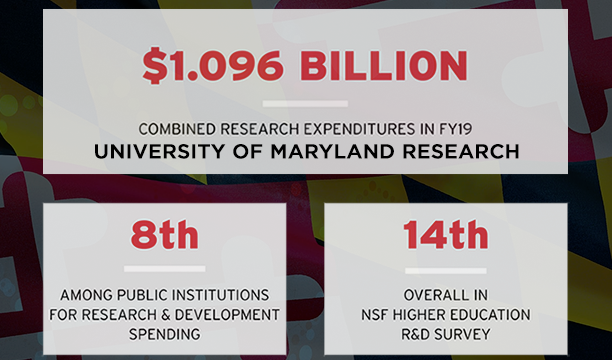News Story
University of Maryland Research Enterprise Ranked Among Top 10 Publics in NSF Higher Education R&D Survey

BALTIMORE and COLLEGE PARK, Md. – The University of Maryland achieved its highest ranking ever in the National Science Foundation’s (NSF) Higher Education Research and Development (HERD) survey for fiscal year (FY) 2019, placing 14th overall nationally and 8th among all public institutions in Research & Development (R&D) spending. For the first time, the University of Maryland, College Park and the University of Maryland, Baltimore were linked together as one research enterprise in the ranking, with combined research expenditures of $1.1 billion.
University of Maryland research has expanded its broad impact in recent years through a strategic partnership called MPowering the State (MPower), which was made possible by the late Honorable Thomas V. “Mike” Miller, Jr., Governor Larry Hogan, Senator Bill Ferguson and the Maryland General Assembly. Established in 2012 and formalized in 2016 as part of the University of Maryland Strategic Partnership Act of 2016, this paved the way for the University of Maryland, College Park and the University of Maryland, Baltimore to combine their research, aligning not only research initiatives, but also leadership.In 2018, Laurie E. Locascio, PhD, was appointed to lead the joint research enterprise as Vice President for Research.
The HERD survey is the primary source of information on R&D expenditures at U.S. colleges and universities and is widely recognized as the preeminent national university ranking for higher education institutions engaged in sponsored research.
“Through the University of Maryland Strategic Partnership, the University of Maryland has become a world-class research enterprise—one with the power, depth and reach to discover knowledge, innovations and technologies. These advances are vital to meeting the challenges facing our world, including the COVID-19 pandemic, climate change, and racial, economic, and health care injustice,” said University of Maryland, College Park President Darryll Pines. “We are proud to be among the top research institutions, which is reflected in our collaborative approach.”
The University of Maryland conducts advanced research in a broad array of fields, including:
- police-community relationships and expanding research and training;
- neuroscience, virtual and augmented reality, biomedical devices, and data analytics; and
- the opioid epidemic in Maryland and the United States
Recent cross-campus research initiatives have also responded to COVID-19 and the threat of future pandemics. The teams address the pandemic from multidisciplinary angles including medicine, engineering, pharmacy, and social and behavioral science, and are working to improve acceptance of vaccines among minority communities, develop new rapid testing methods, and better understand the SARS-CoV-2 spike protein.
“The speed with which we have established collaborative research teams to address challenges imposed by the coronavirus pandemic is a powerful statement about the effectiveness and impact of our joint research enterprise. We are leveraging the expertise of virologists, physicians, and pharmacologists in Baltimore with computer scientists, epidemiologists, and molecular biologists in College Park,” said University of Maryland, Baltimore President Bruce E. Jarrell. “Together, we are addressing today’s urgent needs, as well as the challenges of the future.”
With this new ranking, the state of Maryland joins an elite group of six states with more than one research university conducting research at or above $1 billion per year.
“Our University of Maryland research enterprise provides the opportunity for us to engage in exciting new areas of research that combine the strengths of experts in Baltimore and College Park to take on the world’s greatest challenges,” said Vice President for Research Laurie E. Locascio. “This ranking reflects our status as a thriving and powerful research engine.”
The strategic partnership has created more than 20 academic collaborations; a successful joint tech transfer and commercialization office; and 25 programs and centers, including the Institute for Bioscience and Biotechnology Research (IBBR), the Maryland Blended Reality Center, the Center for Brain Health and Human Performance, and the Support, Advocacy, Freedom and Empowerment (SAFE) Center for Human Trafficking Survivors.
To learn more about MPower, visit mpower.maryland.edu.
About the University of Maryland Strategic Partnership: MPowering the State
The University of Maryland Strategic Partnership: MPowering the State is a collaboration between the state of Maryland’s two most powerful public research institutions: the University of Maryland, Baltimore and the University of Maryland, College Park . It leverages the sizable strengths and complementary missions of both institutions to strengthen Maryland’s innovation economy, advance interdisciplinary research, create opportunities for students, and solve important problems for the people of Maryland and the nation. Working together, UMB and UMCP achieve innovation and impact through collaboration.
The University of Maryland Strategic Partnership Act of 2016 strengthened and formalized the structured relationship between UMB and UMCP, which began in 2012. The law deepens the alliance and enables UMB and UMCP to pursue even greater transformative change and impact, far surpassing what each institution could do independent of the other.
Published February 1, 2021









